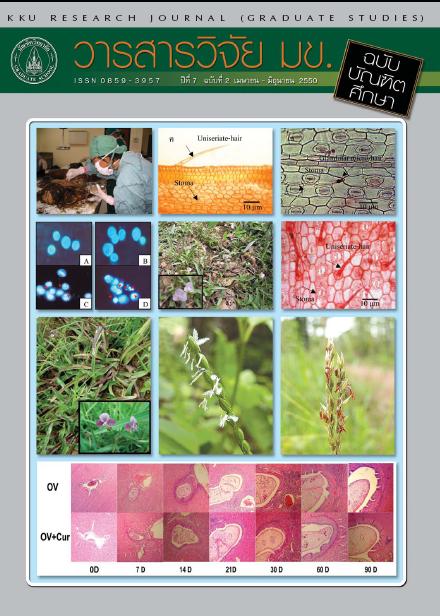Comparative Pharmacognostic and Antioxidant Activity Studies of Three Murdannia species (Family Commelinaceae)(การศึกษาเปรียบเทียบทางเภสัชเวทและฤทธิ์ต้านออกซิเดชันของพืช 3 ชนิดในสกุล Murdannia (วงศ์ Commelinaceae))
Keywords:
Commelinaceae, Pharmacognostic(การศึกษาทางเภสัชเวท), Antioxidant activity(ฤทธิ์ต้านออกซิเดชัน)Abstract
การศึกษาเปรียบเทียบทางเภสัชเวทของพืชสมุนไพร 3 ชนิด ในสกุล Murdannia (วงศ์ Commelinaceae) คือหญ้าปักกิ่ง (M. bracteata), ผักลืมผัวใหญ่ (M. loriformis) และกินกุ้งน้อย (M. nudiflora) ด้วยวิธีศึกษาจุลลักษณะวินิจฉัยแผ่นใบ คุณสมบัติทางเคมีกายภาพ และทินเลเยอร์โครมาโทกราฟฟีสามารถแยกความแตกต่างของพืชสมุนไพรดังกล่าวได้ โดยพบว่าจุลลักษณะวินิจฉัยของแผ่นใบคือ ลักษณะปรากฏของลวดลายคิวทินและขนขนาดใหญ่ ลักษณะวินิจฉัยทางเคมีคือ ปริมาณสารสกัดในเมทธานอลมีความแตกต่างอย่างชัดเจนในการศึกษาหาปริมาณฟีนอลิค และทินเลเยอร์โครมาโทแกรม สำหรับการศึกษาฤทธิ์ต้านออกซิเดชันพบว่าสารสกัดด้วยเมทธานอลของ M. bracteata มีฤทธิ์ต้านออกซิเดชันสูงสุดเมื่อศึกษาด้วยวิธี 1,1-diphenyl-2-picrilhydrazyl (DPPH) และวิธี The ability of ferric reducing-antioxidant power (FRAP) ส่วนสารสกัดด้วยน้ำของ M. nudiflora มีความสามารถต้านการเกิดปฏิกิริยาออกซิเดชันของไขมันได้ดีที่สุดThe comparative pharmacognostic studies for three Murdannia species (Family Commelinaceae), M. bracteata, M. loriformis and M. nudiflora, were conducted using methods of diagnostic microscopic studies, leaf scraping and leaf clearing; phytochemical methods, physico-chemical value and thin layer chromatography. Theses methods are found to be useful for the diagnosis. Cutin pattern and macro-hairs were distinguished based on microscopic characters. The evaluations of phytochemical studies, phenolic contents and thin layer chromatogram, have been valuable tools for pharmacognostic identification. In the determining of antioxidant activity, we found that crude methanolic extracts of M. bracteata showed the highest of antioxidant activity using 1,1-diphenyl-2-picrilhydrazyl (DPPH) and The ability of ferric reducing-antioxidant power (FRAP) methods. Whereas the water extraction of M. nudiflora was found to be the highest of inhibitory activity in lipid peroxidation.



